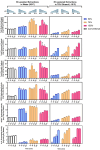Exploring hydrodynamic cavitation for citrus waste valorisation in Malta: from beverage enhancement to potato sprouting suppression and water remediation
- PMID: 38860238
- PMCID: PMC11163080
- DOI: 10.3389/fchem.2024.1411727
Exploring hydrodynamic cavitation for citrus waste valorisation in Malta: from beverage enhancement to potato sprouting suppression and water remediation
Abstract
Introduction: The endorsement of circular economy, zero-waste, and sustainable development by the EU and UN has promoted non-thermal technologies in agro-food and health industries. While northern European countries rapidly integrate these technologies, their implementation in Mediterranean food-supply chains remains uncertain. Aims: We evaluated the usefulness of hydrodynamic cavitation (HC) for valorizing orange peel waste in the fresh orange juice supply chain of the Maltese Islands. Method: We assessed: a) the effectiveness of HC in extracting bioactive compounds from orange peels (Citrus sinensis) in water (35°C) and 70% (v/v) ethanol (-10°C) over time, compared to conventional maceration, and b) the potato sprouting-suppression and biosorbent potential of the processed peel for copper, nitrate, and nitrite binding. Results: Prolonged HC-assisted extractions in water (high cavitation numbers), damaged and/or oxidized bioactive compounds, with flavonoids and ascorbic acid being more sensitive, whereas cold ethanolic extractions preserved the compounds involved in radical scavenging. HC-processing adequately modified the peel, enabling its use as a potato suppressant and biosorbent for copper, nitrate, and nitrite. Conclusion: Coupling HC-assisted bioactive compound extractions with using leftover peel for potato-sprouting prevention and as biosorbent for water pollutant removal offers a straightforward approach to promoting circular economic practices and sustainable agriculture in Malta.
Keywords: citrus waste; green solvents; heavy metals; hydrodynamic cavitation; nitrates; nitrites; potato sprouting; water remediation.
Copyright © 2024 Psakis, Lia, Valdramidis and Gatt.
Conflict of interest statement
The authors declare that the research was conducted in the absence of any commercial or financial relationships that could be construed as a potential conflict of interest.
Figures


References
-
- Abdulrazak N. Z. (2016). Sorption of nitrate salts from wastewater without and with modification orange peel. Iraqi J. Chem. Petroleum Eng. 17 (3), 109–116. 10.31699/IJCPE.2016.3.10 - DOI
-
- Ahmad J., Langrish T. A. G. (2012). Optimisation of total phenolic acids extraction from Mandarin peels using microwave energy: the importance of the Maillard reaction. J. Food Eng. 109 (1), 162–174. 10.1016/j.jfoodeng.2011.09.017 - DOI
LinkOut - more resources
Full Text Sources

